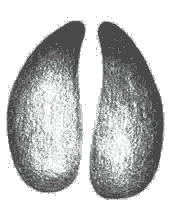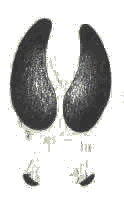ELK Wapiti (Cervus elaphus)
Ontario, Canada
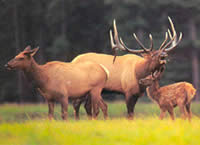 The
elk are also called "Wapiti", which is the Indian word
for "white" referring the color of the animal's rump.
They are named just like cattle: cow, bull, calf.
The
elk are also called "Wapiti", which is the Indian word
for "white" referring the color of the animal's rump.
They are named just like cattle: cow, bull, calf.
Although "elk" is the British name for the moose, it was mistakenly given to the "Wapiti" by early settlers. Wapiti actually comes from the Shawnee Indian language and means "white" referring the color of the animal's rump.
In the fall, breeding season the bulls fight, sometimes to the death, for a harem. The bull elk will stand on its rear legs and strike out with his sharp, cloven hooves. Not only are the bulls strong, they are very fast, running up to 55 kilometers per hour (35 mph), and, unlike deer, they can move through the forest almost silently. The calves are born with white spots for camouflage just like a deer fawn.
Appearance
 After
the moose, it is the second largest member of the deer family. Elk
have large antlers, long slender legs, and a thick neck. They are
either brown or tan on the upper half of their body, and the lower
half of their body is much darker. Their tail and rump are also
brown with a tint of yellow to a light or even white rump under
its tail and bucks have dark manes around the throat area.
After
the moose, it is the second largest member of the deer family. Elk
have large antlers, long slender legs, and a thick neck. They are
either brown or tan on the upper half of their body, and the lower
half of their body is much darker. Their tail and rump are also
brown with a tint of yellow to a light or even white rump under
its tail and bucks have dark manes around the throat area.
Bucks have multi-tined antlers, reaching six on each side during
full maturity. The main beam can reach up to five feet in length.
Juveniles have spots until they are about three or four months old.
Each March the bulls shed their rack of antlers. The rack will drop off completely and the next one is already starting to grow. The new antlers, which grow almost an inch a day, are filled with blood vessels and can weigh up to 35 pounds. The antlers have a velvet-like covering, which is why we call this process "in the velvet." They will reach their full length in midsummer when the blood vessels inside dry up and the much-lighter antler becomes calcified like a bone. Preparing himself for breeding season, the bull runs the velvet off on tree limbs and sharpens the tines.
Habitat
Elk habitat varies throughout the year. In the summer elk are found in higher elevation mountain pastures, and in the winter, elk prefer lower elevations on wooded slopes in densely populated forests.
It can be found near the edge of the forest, in swamps, and in open pastures or glades. During the day, it hides in the forest. Elk are primarily nocturnal, but are especially active at dusk and dawn. It is more active during the night and so is seldom seen by people.
Food
Elk are considered grazers, eating woody vegetation, lichen, grasses, woody stems, tree bark, and soft green plants.
Range
Elk populations that once ranged throughout most of North America dwindled as farms and settlements took over their habitats, while hunting also played a role. Fortunately today's elk herds appear to be very stable.
The elk or wapiti is found in small numbers in Southern Ontario and the southern half of Northern Ontario.
In North Hastings area, as well as Province wide (Ontario), an initiative to reintroduce elk began in last few years. (2000)
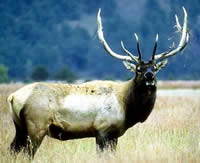 Behavior
Behavior
To protect elk calves from predators, a cow will hide her newborn in a log or shrub, or among tall grasses, for the first few weeks of its life. The calves wear camouflaging white spots and have very little scent, which helps keep them hidden from predators. To avoid leading predators to her calf, the cow keeps watch from a safe distance, visiting only periodically during the day to let it nurse.
Females usually travel with their young calves in small herds. This is for protection. Cows are vigilant, however, and will chase off any predators that get too close, using her powerful front hooves as weapons. If wolves attack the herd, females will work together running at and kicking coyotes, or they will run as a group from larger meat-eaters. This helps protect the weak calves. Wolves more often attack single animals.
Bull elks usually live on their own during the summer when they travel great distances to feed heavily and build up muscle and fat for the rutting season. In open areas, males, too, may group together for added protection during the summer. Although bulls herd separately, they still remain near cow-dominated herds.
After a few weeks, the calves have grown strong enough to keep up and will join the rest of the herd.
Larger elk herds are usually found in open areas, while smaller herds prefer wooded areas. The size of the herd varies depending on the amount of resources, terrain, and cover. Herds can be composed of three hundred to four hundred elk.
Elk often move through the forest quickly. The elk moves through the forest almost without a sound, unlike the deer or moose, which sometimes can be heard crashing through the woods. In open areas the bull or male elk can run at over 55 kilometers per hour(35 mph). Both sexes are good swimmers.
Because it lives in more open areas than the white-tailed deer, the elk has a higher-pitched bugle or call that carries well over open spaces.
Elk vocalize differently depending on their age.
Young elk squeal, adults snort and grunt, and cows neigh to their calves. Alarmed elk emit a sharp, barking snort. The elk also grunts, snorts and, especially when young, squeals.
A bull elk's "bugle" is a challenge to other bulls and a call of domination to cow elk. The bugle starts as a bellow, changes quickly to a high-pitched whistle (which carries the greatest distance), and ends with a series of grunts.
Breeding Biology
Elk breed in late August through November, reaching a peak in October and November.
During the fall rutting (mating) season, a male marks out a territory by thrashed saplings and large shrubs; "rubs" (stripping bark) on saplings and small trees made as the male polishes his antlers, leaving a scent. He leaves this scent using a gland on his face. He also urinates on vegetation (which he tosses on his back using his antlers) and sprays urine on his belly, mane, and face. The urine has a scent of male hormones which tell the female he is ready to mate. During the rutting season, the bull rarely eats. He uses much energy to make his bugle calls that carry for kilometers. This bugle call tells other bulls to keep out of his territory and tells females where he is to be found. If another male invades his area they fight and the winner keeps the territory. Unlike caribou, the female or cow elk selects her mate. She goes to the bull and becomes part of his harem or group of cows.
Bulls fight using their antlers. These clashes seldom cause much harm, but could lead to minor injury or death.
Among the deer family, bull elks attract the largest harems with as many as 60 cows. This large harem is more common west of Ontario where there are more elks. The cow can easily leave during fights between bulls or when the bull is paying attention to other cows. She can be sure that the loudest bull with the best antler spread is the strongest and best bull with which to mate. It takes considerable muscle to hold up those antlers.
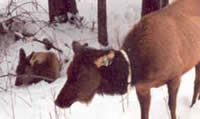 After
the young develop for 255 to 275 days (8.5 - 9 months) in their
mothers' bodies, they are born weighing 11 to 18 kilograms (25 -
40 lbs). The cow usually gives birth to one, sometimes two white-spotted
calves while she is alone. The calf lies hidden on the ground for
a few days. After a week the cow and calf rejoin the herd. The calf
feeds on its mother's milk for a month, but may suckle for nine
months. Female elks mature in 2.5 years. The male is fully grown
in two years but must wait until it is four or five years old before
it can challenge other stags (bulls).
After
the young develop for 255 to 275 days (8.5 - 9 months) in their
mothers' bodies, they are born weighing 11 to 18 kilograms (25 -
40 lbs). The cow usually gives birth to one, sometimes two white-spotted
calves while she is alone. The calf lies hidden on the ground for
a few days. After a week the cow and calf rejoin the herd. The calf
feeds on its mother's milk for a month, but may suckle for nine
months. Female elks mature in 2.5 years. The male is fully grown
in two years but must wait until it is four or five years old before
it can challenge other stags (bulls).
Predators/Threats
The main enemies of elk are wolves, lynx, and coyotes. Wolverines, bobcats, black bears, and golden eagles eat unprotected calves.
Mountain lion and bear are the main predators of elk.
Bulls fight using their antlers. These clashes seldom cause much harm, but could lead to minor injury or death.
Lifespan
Elks live from 14 to 26 years in the wild. There were once many more of these large mammals, but people have killed many for food and to protect cattle pastures.
Antlers:
The male has slender antlers that can be 150 cm across and sweep back over the shoulders out of the way when the elk eats or runs.
These are made of fast-growing bone -- so fast, in fact, that scientists think studying antlers may reveal clues about many types of cancer. Antlers can grow up to an inch a day! Contrary to what most people think, the number of branches or points does not signify an animals' age. Elk will frequently polish their antlers on trees, leaving tell-tale "rubs" -- areas of trees about four feet off the ground scraped bare of bark.
Scat:
When feeding in lush pastures in summer and early fall, flattened chips similar to dung of domestic cattle; in winter, when chief foods are dried grasses and browse, dark pellets similar to deer scat but larger, sometimes more than 1" (25 mm) long.
Track
Elk leave a neat, alternating track with large, rounded prints, often in well-worn winter paths. Hind print will sometimes double register slightly ahead of the fore print. In deep snow, or when an Elk gallops (toes spread) the dew claws may register. Good place to look for Elk tracks is in the soft mud by summer ponds, where Elk like to drink and sometimes splash around.
Prints:
|
Fore and Hind Prints
Length: 3.2 - 5.0 in (8.1 - 13 cm)
Width: 2.5 - 4.5 in (6.4 - 11 cm)
Straddle
7.0 - 12 in (18 - 30 cm)
Stride
Walking: 16 - 34 in (41 - 86 cm)
Galloping: 3.3 - 7.8 ft (1.0 - 2.4 m)
Group Length: to 6.3 ft (1.9 m)
Size (Stag > Hind))
Height: 4.0 - 5.0 ft (1.2 - 1.5 m)
Length: 6.5 - 10 ft (2.0 - 3.0 m)
Weight
Males: 270 to 495 kg (600 to 1,089 pounds)
Females: 203 and 293 kg (450 to 650 pounds)
Similar Species:
It is Illegal to hunt Elk in Ontario
A 5 - 6 month elk calf will be the same
size as an adult white-tail doe
Elk |
Deer |
|
Color: |
Black legs and Neck | Legs same colour as their bodies, and White throat patch |
Tails: |
Short | Long with white underside |
Antlers: |
Sweep Back | Curve Forward |
Rump: |
Tan rump patch | |
Size: |
1.2 - 1.5 m (4 - 5 ft) at shoulders | 0.9 - 1.1 m (3 - 3.5 ft) at shoulders |
BANCROFT/NORTH HASTINGS ELK RESTORATION PROJECT
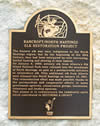
The Eastern Elk was once indigenous to the North Hastings region, but by the beginning of the 20th Century, they had been extirpated by over harvesting, market hunting and altering of their habitat.
On January 9, 2000, seventy elk from Alberta's Elk Island National Park were released into the woodlands of North Hastings, as part of a province-wide initiative to reintroduce elk. Fifty additional elk from Alberta were released into North Hastings on January 13, 2001. This reintroduction effort was made possible thanks to the partnership and cooperative efforts of many government agencies, conservation groups, businesses, volunteers and funding agencies.
This plaque is to commemorate the community spirit contributed to Restoring a Legacy.
Plaque located in Bancroft Millennium Park
